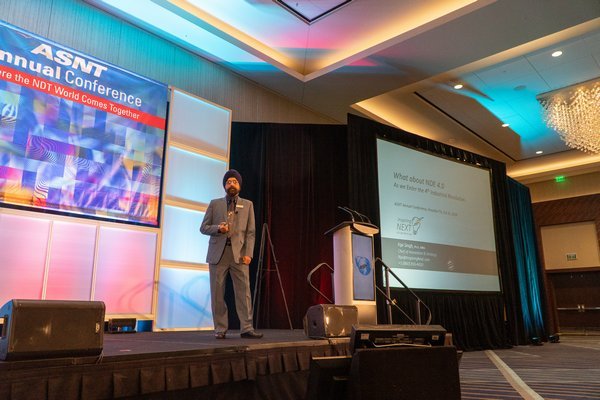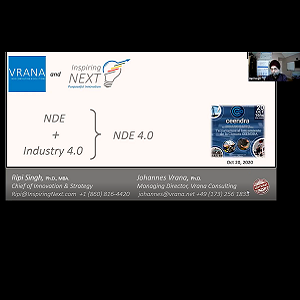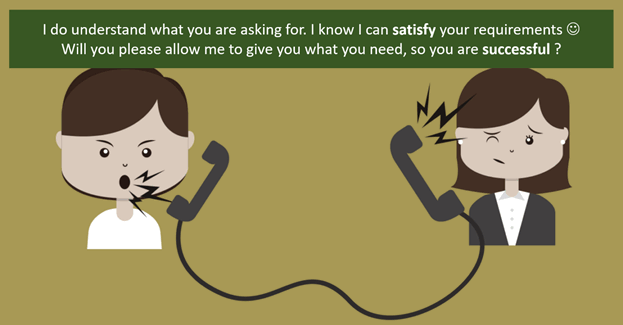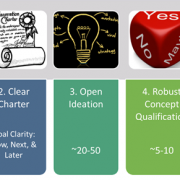Has anyone ever built muscles by taking a tour of the gym?
Really?
Bringing innovation into an organization culture is like building a mental muscle. You cannot learn it online or through watching panel discussions amongst thought leaders. It requires sustained effort for long period of time, and painful learning.
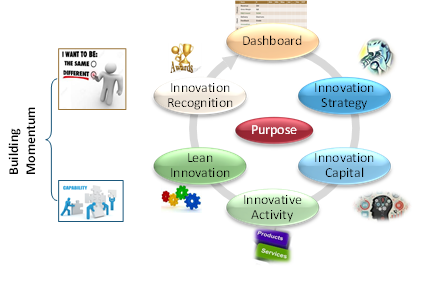
Basic Physics behind an Organizational Behavior
Organizations seem to follow some basic principles of physics. For example
- Friction: Opposing force resisting relative motion.
- Inertia: Tendency to do nothing or to remain unchanged.
- Gravity: Left to themselves, unsupported objects will fall to the ground.
- Energy: The capacity for doing work.
- Momentum: Impetus gained by a moving object.
When an individual or a team tries to get innovative, to change a process or product, essentially trying to move it from its current state to a different state; it encounters both friction and inertia. The team has to put in a lot of energy to get it moving, and to build and sustain the momentum.
Overcoming Inertia and Friction
Organizations have inertia and internal friction that will hold them back from a successful positive transition. But, if you can build momentum through proper infusion of energy, you can make a lasting enterprise-wide change.
Start by sending the right message to the 13% early adaptors, and they will join the 3% innovators already working in that direction. The 34% of early majority will need some kind of objective and training to follow through. The 34% late majority would need incentives and tangible rewards in addition to the objectives and capability training. Never mind the last 16% laggards and CAVE people, they will find a different role.
Building Momentum
In Volume-3, we discussed 4 tracks of activities to build an innovation profile. Consistent execution will help build the momentum. Leadership needs to think of the following steps as a wheel
- Be clear about the Innovation Purpose, and the vision of success.
- Create, communicate, and use the two sheets of music, the Innovation Strategy (Roadmap), and the Dashboard to track the progress.
- Build the Innovation Capital, by investing in talent and know-how.
- Inspire talent to engage in Innovation Activity to realize the roadmap.
- Keep Innovation Lean by aligning people, products, and markets.
- Recognize and reward teams for performance and learnings.
- Update the roadmap and dashboard annually and go back to step 2.
Keep rotating this flywheel and build a momentum that would be hard to stop. Purpose, strategy, and rewards provide the willingness to innovate. Capital and activities build the capability. Lean reduces internal friction. Collectively, they build the culture of innovation, over a few years. It is a mental muscle.
Just like a few workout sessions at the local gym won’t build your body muscle, a few successful projects won’t build the mental muscle of your organization. You will have to go through many projects, over the years, and slowly change the basic behavior. I get into conversations with senior leaders who think that a 2-day workshop on ideation or innovation is all they need, and after that, it will happen on its own. A 2-day workshop is just like taking a tour of the gym.
Lesson from the Coronavirus Pandemic
In March 2020, within 2 weeks, America went from business as usual to a complete stop, except essential services. The markets were shutdown, social distancing put in force, almost everyone working from home, no more parties, weddings postponed, no access to beaches, bars, or nightlife. The level of change that would normally take a decade was visible in a blink of an eye. Situation updates and restrictions were being brought into the workforce by the hour. What was at stake? Life. No one asked you to think or act Out of the Box. Your box was just crushed by the tiniest invisible life form, leaving everyone scrambling to find a new box to think in. Innovation was seen all across from primary life-saving equipment, to communication, to support structure. Innovation was not a struggle at all. Organizational leadership was open to all sorts of ideas to keep their employees safe and the business afloat. They were willing to quick test, follow any successful option, and learn.
Where did that innovation muscle strength came from? Life saving rush of Adrenaline!
In Summary,
There are many reasons, excuses, and myths about why innovation does not succeed. I concur with Bill Fischer that it never gets started or supported by leadership even if it starts. The primary struggle is a leadership mindset, which slowly erodes employee morale to innovate. In some sense companies have successfully managed to promote productivity performers to the leadership roles, putting innovators and innovation on the back seat. Will the pandemic change that? Will it mark the start of an innovator’s era with a very different form of struggle, the struggle to let innovators lead, for a while.
If you like this blog post, you will like my book series “Inspiring Next Innovation ….” available on Amazon and summarized in these book launch webinars on YouTube.
For Leaders –
Inspiring Next Innovation Purpose,
Available on Amazon Watch on YouTube
For Innovators –
Inspiring Next Innovation Value Chain,
Available on Amazon Watch on YouTube
For Managers –
Inspiring Next Innovation Framework,
Available on Amazon Watch on YouTube
For Leaders –
Inspiring Next Innovation Mindset,
Available on Amazon Watch on YouTube
To engage with the author – please register for upcoming virtual sessions.

